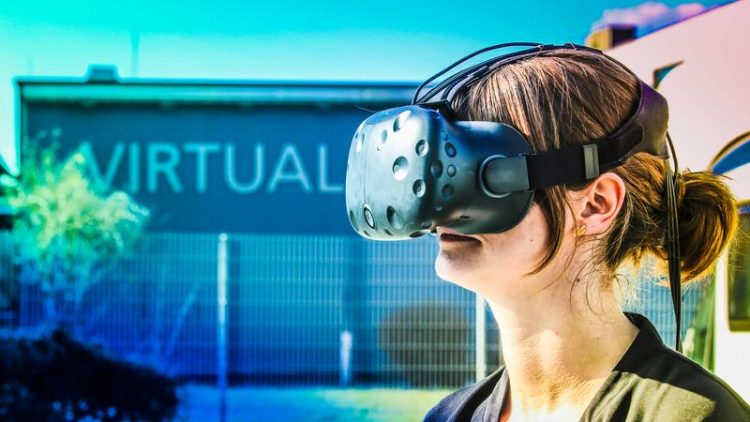Human-Centred Product Development Using Virtual Reality

Modern virtual reality (VR) technologies play an essential role in the improvement of the human-centred research and development process. Photo: Jacob Müller
Modern virtual reality (VR) technologies are not only common in the entertainment industry, they are increasingly becoming prevalent in the area of research and development. With VR goggles and motion tracking, highly realistic environments can be created, which allow for a nearly natural immersive setting.
As a result, new so-called “prototyping methods” for human-centred development can be implemented. Prototyping is used in the product development process in order to investigate usage-related optimisations – for example, via ergonomic and usability surveys, or via acceptance and design evaluations.
The Professorship of Ergonomics and Innovation Management (Prof. Dr. Angelika Bullinger-Hoffmann) at Chemnitz University of Technology uses this approach as a part of their research and development project titled “Platform for virtual prototype evaluation in early phases of product development” (virPro).
Together with CMC-Kiesel GmbH, a specialist in VR programming, Chemnitz University of Technology is developing a VR application in virPro, in which highly practice-oriented, usage-related investigations into product development are carried out.
“This tool is intended to create a simulation and evaluation environment in which both developers and users alike can experience and test the design schemes in simulated field environments,” explains Dr. Frank Dittrich, Cluster Manager for Product Engineering at the Professorship for Ergonomics and Innovation Management at Chemnitz University of Technology.
Among other things, it should also allow for cooperative functions. This will allow geographically dispersed teams to work together in the VR environment. Gesture and voice control interaction methods are integrated for intuitive and natural use, and the utilisation of assessment and documentation tools with automated ratings is designed to streamline the development process.
The research and development project is set to be funded with around 380,000 euros as of the beginning of 2021, as a part of the “Central Innovation Programme for SMEs” (ZIM) at the Federal Ministry for Economic Affairs and Energy (BMWi). This is carried out as a part of the AVARE Network (Application of Virtual and Augmented Reality) at Chemnitz University of Technology, itself a component of the ZIM.
Cost efficiency, thanks to VR
In addition, the new method also offers considerable potential for savings during the course of product development. Prototypes that used to exist in the past, from cardboard models up to elaborately designed, functional demonstration models, can now be tested in VR as virtual prototypes.
This offers a distinct advantage in that even at a very early stage in the development process, products that appear to be real can be produced at a fraction of the cost of their physically-existing counterparts. In addition, virtual field environments can be generated, which make the overall experience of using the product more realistic.
The results of the virPro project should serve not only to improve the product development process itself, but also to be utilised as a part of the human-centred research process. For example, usage studies that previously depended on real prototypes should be able to take place in simulated testing environments with simulated prototypes. The Professorship for Ergonomics and Innovation Management has already garnered good experience in numerous research projects:
“In various domains such as human-robot collaboration, age-appropriate assistance systems or security technology, we have shown that the implementation of usage studies in VR offers many advantages that laboratory studies do not, and in addition, corresponding studies can be accordingly carried out, already very early in the research and development process,” explains Dittrich.
With the new tool that is under development in the project, the Professorship of Ergonomics and Innovation Management wants to further expand their research that is taking place at the interface between humans and technology, and shine light on the human-related aspects of technology design.
Background: AVARE: The goal of AVARE, founded by Dr.-Ing. Philipp Klimant (Professorship of Machine Tool Design and Forming Technology), is the establishment of a network of research institutes and companies that solve existing problems in the manufacturing industry, using tools of “virtual technologies”.
A total of 22 partners from industry and research have joined the network, aiming to explore and bring applications for virtual technologies to market. At the same time, AVARE combines application-driven research with the opportunity to get to know virtual technologies and their field of application. AVARE is particularly geared towards making these advantages of virtual technologies known to small and medium-sized companies, and to help them find new applications for these technologies.
Further information about the virPro project: Frank Dittrich, Professorship of Ergonomics and Innovation Management at Chemnitz University of Technology, Phone 0371 531-37878, Email frank.dittrich@mb.tu-chemnitz.de.
Further information about the AVARE Network: Dr. Philipp Klimant, Professorship of Machine Tools and Forming Technology, Phone 0371 531-36911, Email philipp.klimant@mb.tu-chemnitz.de.
Media Contact
All latest news from the category: Information Technology
Here you can find a summary of innovations in the fields of information and data processing and up-to-date developments on IT equipment and hardware.
This area covers topics such as IT services, IT architectures, IT management and telecommunications.
Newest articles

Properties of new materials for microchips
… can now be measured well. Reseachers of Delft University of Technology demonstrated measuring performance properties of ultrathin silicon membranes. Making ever smaller and more powerful chips requires new ultrathin…

Floating solar’s potential
… to support sustainable development by addressing climate, water, and energy goals holistically. A new study published this week in Nature Energy raises the potential for floating solar photovoltaics (FPV)…

Skyrmions move at record speeds
… a step towards the computing of the future. An international research team led by scientists from the CNRS1 has discovered that the magnetic nanobubbles2 known as skyrmions can be…





















